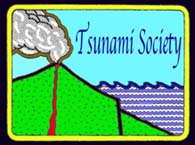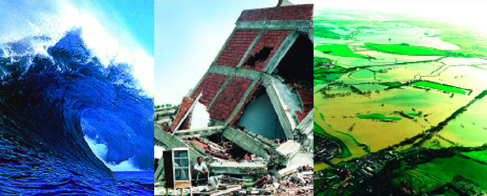..........................................................
ABSTRACTS
for Volume 31, No. 2
ABSTRACTS for Volume 31, No 2
Complete Journal - STHVol31N2Y2012.pdf ( 16.1 MB) Compressed Journal (1.6 MB)
SEA LEVEL SIGNALS CORRECTION FOR THE 2011 TOHOKU TSUNAMI (1.2 MB)
A. Annunziato - Joint Research Centre, European Commission, Ispra, ITALY
ABSTRACT
The paper analyses the signals measured during the M9.0 Tohoku Tsunami in order to identify the effect of the subsidence on the measurements and to determine correction factors to be applied to the measurements. The objective is to have a coherent set of measurements that can allow the correct estimation of the source term for this event through inversion techniques. In fact the inversion techniques tend to minimize the difference between the measured signals and the calculated value; which means that in the initial period and also for the peak, the solution found without considering this correction tends to get higher values of the source (the peak in some cases is almost 1.4 m higher on a maximum of 4-5 m, thus is not negligible).
The amount of the correction has been determined using the long-term displacement shown in the measurements; the subsidence estimates are also compared with the values obtained using GPS instruments. The analysis shows that the subsidence has a notable influence on the measurements where the deformation is large and that taking into account the deformation in the signals may improve the quality of the estimation of the initial deformation.
Key Words: Tsunami, Sea Level Measurements, GPS, Tsunami Source, Earth Deformation
Science of Tsunami Hazards, Vol. 31, No. 2, pages 99 - 111 (2012)
INDIAN OCEAN TSUNAMI OF 26 DECEMBER 2004 - Analysis of Seismic Source Mechanism (10.3 MB) Compressed (508 KB)
R. Mazova - N.Novgorod State Tech.University, Nizhny Novgorod, Russia
B. Kisel’man - P. P. Shirshov Institute of Oceanology RAS, Moscow, Russia
Dept. of Circuits & Telecommun, N.N. State Tech.Univ., Nizhny Novgorod, Russia
N. Baranova - Magister, Dept. of Applied Mathematics, N.N. State Technical University, Nizhny Novgorod, Russia
L. Lobkovsky - -Professor, Lab. of Seismology, Institute of Oceanology, Russian Academy of Sciences, Moscow, Russia
ABSTRACT
Based on the keyboard model of tsunamigenic earthquakes, an analysis was performed of the physical aspects of the 26 December 2004 earthquake off Sumatra and of the seismic source of the great tsunami generated in the Indian Ocean. A simplified keyboard model with vertical displacements of keyboard blocks was used for the numerical simulation in defining the tsunami’s generation source and, based on known bathymetry, its subsequent propagation across the Indian Ocean basin. The numerical simulation of the seismic source took into account the oblique character of subduction zone, which was characteristic for this particular earthquake. Furthermore, the analysis evaluated the different scenarios of keyboard blocks motions - corresponding to real seismic and hydro acoustic studies of the earthquake process - as reported in the literature. Adequateness of the calculations performed was verified by comparison of real altimetry records of satellite “Yason-1” with virtual altimetric record, obtained by us for each calculation. The computational analysis helped explain the complex character of the tsunami and of its propagation and energy flux distribution in the Indian Ocean basin.
Key Words: Indian Ocean tsunami, numerical modeling, satellite altimetry, keyboard model
Science of Tsunami Hazards, Vol. 31, No. 2, page 112 - 129 (2012)
GEODYNAMICS OF NAZCA RIDGE'S OBLIQUE SUBDUCTION AND MIGRATION - IMPLICATIONS FOR TSUNAMI GENERATION ALONG CENTRAL AND SOUTHERN PERU: Earthquake and Tsunami of 23 June 2001 (4.6 MB) Compressed (459KB)
George Pararas-Carayannis - Tsunami Society International, Honolulu, Hawaii, USA
ABSTRACT
Peru is in a region of considerable geologic and seismic complexity. Thrust faulting along the boundary where the Nazca plate subducts beneath the South American continent has created three distinct seismic zones. The angle of subduction of the Nazca oceanic plate beneath the South American plate is not uniform along the entire segment of the Peru-Chile Trench. Furthermore, subduction is affected by buoyancy forces of the bounding oceanic ridges and fractures - such as the Mendana Fracture Zone (MFZ) to the North and the Nazca Ridge to the South. This narrow zone is characterized by shallow earthquakes that can generate destructive tsunamis of varied intensities. The present study examines the significance of Nazca Ridge’s oblique subduction and migration to the seismicity of Central/Southern Peru and to tsunami generation. The large tsunamigenic earthquake of 23 June 2001 is presented as a case study. This event generated a destructive, local tsunami that struck Peru’s southern coasts with waves ranging from 3 to 4.6 meters (10-15 feet) and inland inundation that ranged from 1 to 3 km. In order to understand the near and far-field tsunamigenic efficiency of events along Central/Southern Peru and the significance of Nazca Ridge’s oblique subduction, the present study examines further the geologic structure of the region and this quake’s moment tensor analysis, energy release, fault rupture and the spatial distribution of aftershocks. Tsunami source mechanism characteristics for this event are presented, as inferred from seismic intensities, energy releases, fault plane solutions and the use of empirical relationships. The study concludes that the segment of subduction and faulting paralleling the Peru-Chile Trench from about 150 to 180 South, as well as the obliquity of convergent tectonic plate collision in this region, may be the reason for shorter rupture lengths of major earthquakes and the generation of only local destructive tsunamis.
Keywords: Peru earthquake, tsunami, Peru-Chile Trench, seismotectonics, Nazca Ridge
Science of Tsunami Hazards, Vol. 31, No. 2, page 129 - 153 (2012)
..........................................................
Copyright © 2012 - TSUNAMI SOCIETY INTERNATIONAL
-------------------------------------------------------------------------------------------------------------------------------------------




